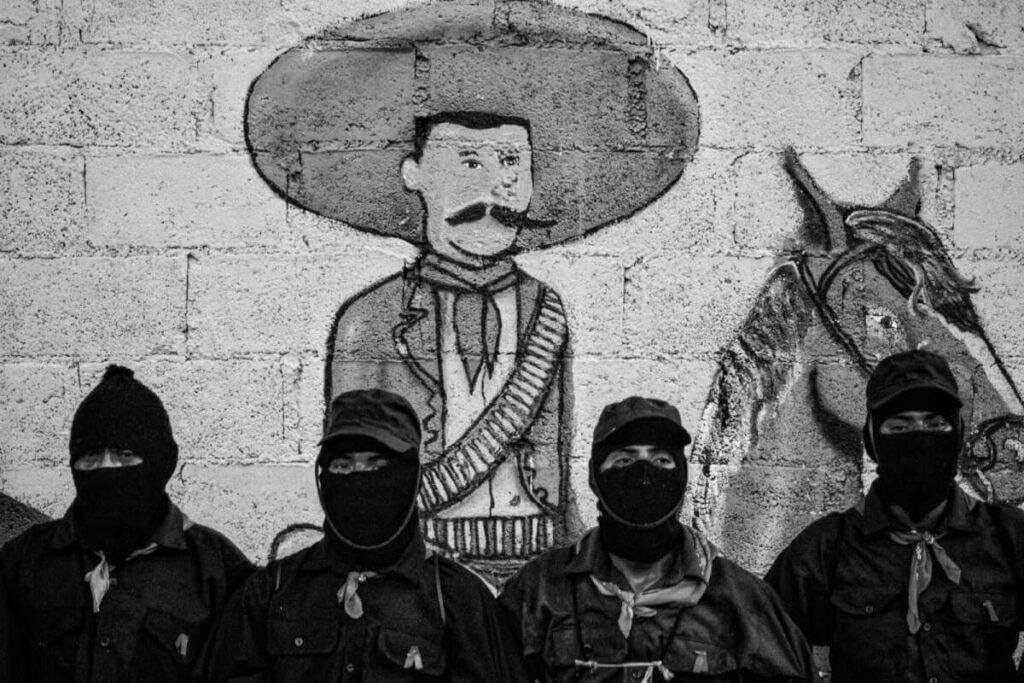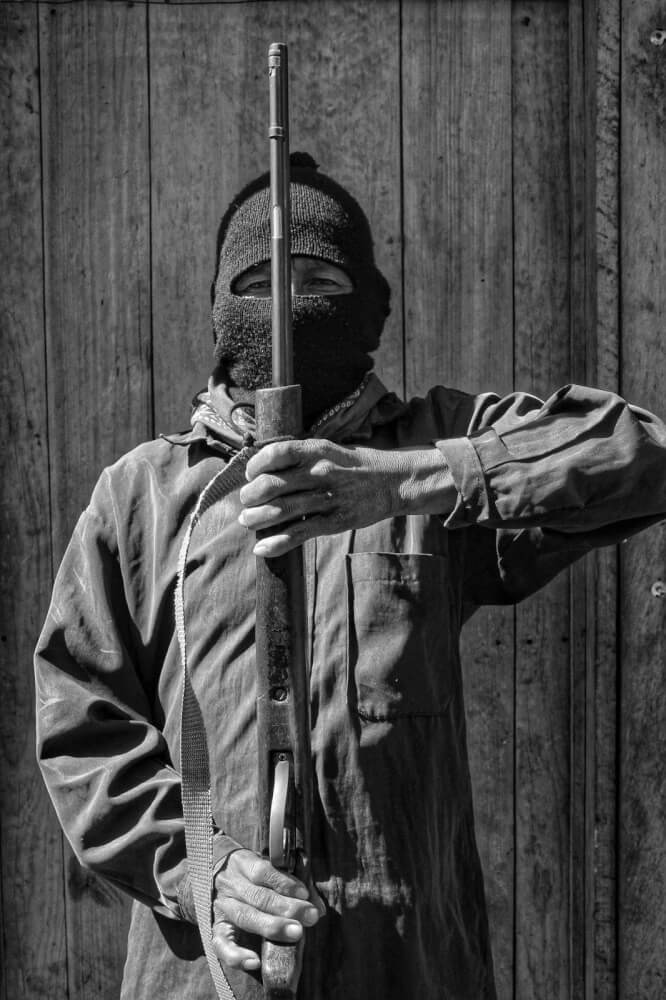Memoir of the War Machetes

It is nighttime at the end of 2022. A crescent moon hangs above us. In the patio of their plot the family gathers to talk with the visitors. Two wooden benches and two log stools form a circle around the fire. Seated very formally and welcoming are Javier, Magda and their family of daughters, sons, a grandson. Immediately Anselmo, a veteran Zapatista militiaman, Javier’s father and neighbor joined in.
Javier places a short and pointed machete, almost a knife or sword, on a couple of logs at his feet.

“If this machete could tell tales. It was my dad’s when the war started.”
Anselmo, in his baseball cap, nods with a short sigh in Tseltal. He smiles like someone looking into a well of endless memories.
Jonás, the little boy, Anselmo’s great-grandson, still shows signs of muted activity. A few steps away are the two wooden bars between stakes that serve as a walker to teach him to walk. In the arms of young Nely is a fourth-generation Zapatista who soon falls asleep in his mother’s milky sea.

The night of the Zapatista Army of National Liberation uprising, Javier was ten years old, Anselmo was about 30 and was a militiaman; he doesn’t speak much, and half in Tseltal, but he makes it clear that he had to remain in the rear guard with the women, the elderly, and minors, and he did not directly participate in the fighting in the city of Ocosingo in the first days of January 1994, where he lost his little brother.
“His little brother took his machete like this one but he was unlucky” and did not return”, Javier says. Other compas did, and they told how they were hidden under some sacks in a ditch when the army arrived. They saw the soldiers’ legs, lashed out with the machete at them, they fell and they quickly took out their weapons.

As part of the conversation, Magda cuts splinters from a piece of ocote pine with the same old machete that is so used and so sharp. Someone says that it is also used to shell corn. They laugh.
The lands where this autonomous community is located were part of a large cattle farm until 1993. The owner, from Ocosingo, never returned. His cows and land were left in terrible condition.
“Just grasslands,” Magda recalls dreamily.

For three decades now, the recovered lands have served better for cornfields, sunflowers, vegetable plantations, and banana groves. Some were left as grasslands. Here there are much fewer cows than before, and few horses, the pasture is small. They have a number of clean water springs on the hill.
Javier was a child that night and remembers his fear:
“We only saw how the compas went to war. We went to the shelter on the mountain. We went into a cave, it was very cold. My dad was one of those who took care of us in the mountains. Even before that day, we kids were scared when the soldiers began to pass by, looking for the guerrillas they had raided in May in the Sierra de Corralchén. It was on the news. The soldiers went through all the valleys and it seemed that they were going to go into the houses. After the war it was different, we had our army to defend us, and we no longer felt the same fear when there were patrols.

Nevertheless, Javier acknowledges that the military occupation in February 1995 after “Zedillo’s betrayal” was also very traumatic. Again they took refuge in the mountains, but this time they had their own army with them, as they still have.
He adds that for weeks before, everyone knew that the uprising was coming. They began to get a lot of meat on credit from the landowner, who used to sell it or give it on credit to peasants and laborers and then forced them to pay, very harshly. But people already knew about the war and that they were not going to need to pay him. Laughter and scintillating comments followed his story.

“When the war started we had eaten a lot of meat”, Javier jokes mischieviously.
The memories of those days and nights that today are part of the history of Mexico take him to the news that the combatant compas brought in the days that followed, the epic or tragic stories that would resound in the mountains, valleys, and ravines in the months and years to come.
”Two compas that were from Altamirano got lost when they were returning from the capture of San Cristóbal and went out through Chanal. They only were only carrying their machetes. They met some people and asked them the way to their community and they said yes, now we will guide you, and two began to walk with them at night. The compas were wearing their militia uniforms and the people saw that. The compas trusted them, they were taken further, and suddenly one of the people hit one of the compas with a machete from behind in the neck and cut off his head. It was left like that, hanging forward. The other compa saw that they were being attacked and defended himself with his machete, killed one of them, but the other one went at him with his machete and cut off his arm. The compa started running with his arm dangling. Finally, he was found by his squad that was out looking for them. They took him away immediately and he was able to heal his arm, he was left one-armed but alive and well.

This bloody tale opens the range of conversation to tales, dreams and ghost stories, in which Javier’s children also participate. They remember the “Sombrerón”, who appears in many forms. He sometimes whistles to the horses, takes them to the hill, braids them and lets them come back. The braid gives the animal more life, one cannot undo it.
They also tell of the “Señora Cortada”, with her lopped leg, who sits on an upright log, just like the ones we are occupying tonight. And if the “Sombrerón” takes you, he will turn your clothes inside out so that you can come back.

“A dishevelled girl appeared here in the courtyard. She was only seen by my mom. She passed right through the patio here, screaming, and even Canela (the nice lame dog that now dozes there) followed in her footsteps”, says Javier.
Nely then reveals the type of nightmares that her teenage brother Antonio has, who laughs shyly next to her.
“One night he woke up sleepwalking repeating: “My uncle’s tacos belong to someone, my uncle’s tacos belong to someone.”
Everyone finds the story hilarious, except Antonio, who smiles wishing the earth would swallow him.

Such was the family scene that I witnessed and heard, I was lucky, somewhere in the Lacandon jungle a few nights before the 29th anniversary of the Zapatista uprising that shook these towns in 1994. In the background, on a wall of a wooden house freshly painted green is a red star and it reads “E.Z.L.N.” in big letters.
In the various rebel communities, the signs on their paths or the murals in some houses, regularly made of wood and in good condition, make this clear, although they contrast with the solid buildings that mostly belong to the families that accept the government programs. In Javier’s community this difference is less evident, unlike other parts of the vast indigenous region of Chiapas where they live in rebellious autonomy.

In the Highlands and other parts of the jungle, inequality is much more pronounced, especially in San Juan Chamula, Chenalhó and Las Margaritas, where illegal businesses and official support have created a kind of middle class or even indigenous bourgeoisie over recent decades of persistent political and economic counterinsurgency policies.
Javier is clear that living in autonomy and being a Zapatista implies an additional effort. But is it worth it. He and his family are not alone. They live in dignified conditions, even with room for good taste and savoir vivre, where hospitality and joy have a place. Daring to rise up against all odds, take the lands of his original homeland, defend them and work on them to sustain autonomy all these years, fills Javier with pride.
What he still does not know, or does not reveal, is whether there will be a New Year’s party or assembly in his Caracol. At least that’s what he says, so you can see that the Zapatistas are always mysterious.

Hermann Bellinghausen
Photos by Mario Olarte
Original version in Spanish at https://desinformemonos.org/la-memoria-de-los-machetes-de-la-guerra/
Translated by Schools for Chiapas.
